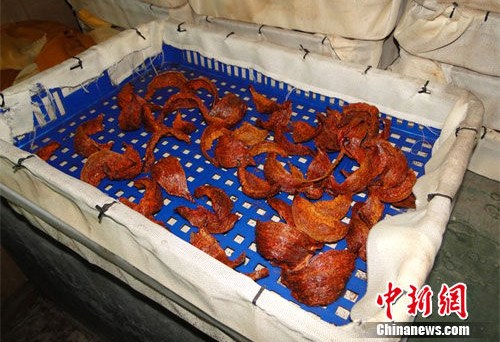The myth of the nest
Since ancient times, Chinese doctors have used red bird nests to enhance the human circulatory system, making the nests expensive and rare.
In a local tonic market in Zhejiang Province, the blood nests range from 25 yuan ($3.9) to 30 yuan ($4.6) per gram, while ordinary bird nests are between 20 yuan ($3.1) and 25 yuan ($3.9). An insider revealed that a cup of blood nest extract is 125 yuan ($19.3) to 150 yuan ($23.2) for about 5 grams. A box of four cups runs about 500 yuan ($77.3) to 600 yuan ($92.8).
Due to high profits and large market demand, dyeing bird nests has become a specialized industry. According to an Indonesian businessman, it takes seven to ten days to dye a bird nest at a cost of between $50 and $100 per kilogram. Nests can be dyed red, light red or yellow according to a customer's requirements. Color cards and dyed samples are even provided to help customers choose.
"The swiftlet's droppings contain plenty of nitrite, and in order to eliminate the bad odor and dirty hair on inferior raw materials for cubilose products, producers have to use chemicals such as hydrogen peroxide, sulfur dioxide and sulfur trioxide, which again adds many toxic and carcinogenic elements," said an unnamed industry insider.
Even if the blood-red cubilose is an authentic product made from red cave nests, safety can still not be ensured. There is no quantity standard for the amount of minerals it might contain, some of which may be harmful elements such as lead and mercury, he added.
Big industry needs regulation
The overflow of fake cubilose products into the market has much to do with the supervision of the industry. In Indonesia and Malaysia for example, the cubilose industry has expanded to a scale of nearly 100 million producers, dominated by small unregulated shops for production, processing and trade.
Jack Lee admitted that the current cubilose producers are mainly home-based workshops, many of which have not registered formally. Stranger still, Indonesia produces 80% of the world's cubilose products, yet it has no famous brands of its own. In essence, Malaysia is the bird nest sweatshop of China.
Lee said they now propose to use salivary acid to identify the authenticity of cubilose products, which would solve the adulteration problem when using protein amount as a major indicator.
In April 2011, the method was approved by Chinese experts. Though it may still take a long time to make it an international standard, the direction has cleared the way for heightened supervision and stricter regulation.


















